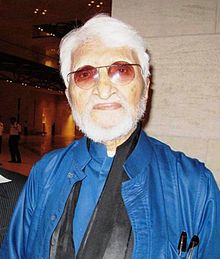M. F. Husain
From Wikipedia, the free encyclopedia
(Redirected from M.F. Husain)
| M.F. Hussain | |
|---|---|
 MF Husain at Museum of Islamic Art, Doha | |
| Birth name | Maqbool Fida Husain |
| Born | 17 September 1915 Pandharpur, Maharashtra, India |
| Died | 9 June 2011 (aged 95) London, England, United Kingdom |
| Nationality | Indian; Qatari (2010–2011)[1] |
| Field | Painting, Drawing, Writer, Film Maker |
| Training | Sir J. J. School of Art |
| Movement | Progressive Art Group |
| Works | Meenaxi a tale of three cities ,Throughh the eyes of a painter |
| Awards | Padma Shri (1955) Padma Bhushan (1973) Padma Vibhushan (1991) |
| Website | www.mfhussain.com |
Maqbool Fida Husain (17 September 1915 – 9 June 2011[2]) commonly known as MF Husain, was an Indian painter and Film Director.
Husain was associated with Indian modernism in the 1940s. His narrative paintings, executed in a modified Cubist style, can be caustic and funny as well as serious and sombre. His themes—usually treated in series—include topics as diverse as Mohandas K. Gandhi, Mother Teresa, theRamayana, the Mahabharata, the British raj, and motifs of Indian urban and rural life. One of the most celebrated and internationally recognized Indian artists of the 20th century, he also received recognition as a printmaker, photographer, and filmmaker.
Biography [edit]
Husain was born into a Muslim family on 17 September 1915 in Pandharpur, Maharashtra to a Sulaymani Bohra family. Primarily self-taught, Husain painted cinema posters in Mumbai early in his career. To earn extra money, he worked for a toy company designing and building toys. He often traveled to Gujarat to paint landscapes when he could afford to.[3]
1940–1965 [edit]
Husain first became well known as an artist in the late 1940s. He was one of the original members of the Bombay Progressive Artists' Group founded by Francis Newton Souza.[4] This was a clique of young artists who wished to break with the nationalist traditions established by the Bengal school of art and to encourage an Indian avant-garde, engaged at an international level. His first U.S.A. exhibit was at India House in New York in 1982. In 1952, his first solo exhibition was held at Zürich and over the next few years, his work was widely seen in Europe and the US. In 1955, he was awarded the prestigious Padma Shri award by the Government of India.[5]
1966–1990 [edit]
In 1967, he made his first film, Through the Eyes of a Painter. It was shown at the Berlin Film Festival and won a Golden Bear(Short Film).[6][7]
M. F. Husain was a special invitee along with Pablo Picasso at the Sao Paulo Biennial (Brazil) in 1971.[8][better source needed] He was awarded thePadma Bhushan in 1973 and was nominated to the Rajya Sabha in 1986.[8][better source needed] He was awarded the Padma Vibhushan in 1991.
1990–2005 [edit]
Indifferent to both religion and politics, Husain, a Muslim by upbringing, treated the gods and goddesses of Hinduism as visual stimuli rather than deities, depicting them unclothed and often in sexually suggestive poses.[9] This earned him the bitter hatred of Hindu nationalist groups, which beginning in the 1990s mounted a campaign of intimidation and violence against him.[2] The paintings in question were created in 1970, but did not become an issue until 1996, when they were printed in Vichar Mimansa, a Hindi monthly magazine, which published them in an article headlined "M.F. Husain: A Painter or Butcher".[2] In response, eight criminal complaints were filed against him. In 2004, Delhi High Court dismissed these complaints of "promoting enmity between different groups ... by painting Hindu goddesses – Durga and Sarswati, that was later compromised by Hindus."[10][11]
In 1998 Husain's house was attacked by Hindu groups like Bajrang Dal and art works were vandalised. The leadership of Shiv Sena endorsed the attack. Twenty-six Bajrang Dal activists were arrested by the police.[12] Protests against Husain also led to the closure of an exhibition in London, England.
He has also produced & directed several movies, including Gaja Gamini (2000) (with his muse Madhuri Dixit who was the subject of a series of his paintings which he signed Fida). The film was intended as a tribute to Ms. Dixit herself.[13][better source needed] In this film she can be seen portraying various forms and manifestations of womanhood including the muse of Kalidasa, the Mona Lisa, a rebel, and musical euphoria. He also appeared in a scene in film Mohabbat, which had Madhuri Dixit in lead role. In the film, the paintings that were supposedly done by Madhuri were actually Husain's.[14] He went on to make Meenaxi: A Tale of Three Cities (with Tabu). The film was pulled out of cinemas a day after some Muslim organisations raised objections to one of the songs in it.[15] The All-India Ulema Council complained that the Qawwali song Noor-un-Ala-Noor was blasphemous. It argued that the song contained words directly taken from the Quran. The council was supported by Muslim organisations like the Milli Council, All-India Muslim Council, Raza Academy, Jamiat-ul-Ulema-e-Hind and Jamat-e-Islami. Husain's son stated that the words were a phrase referring to divine beauty that were being sung by the central character played by Tabu. He said there was no intention to offend. Following the wave of protests the enraged artist withdrew his movie from cinemas. The film was well received by the critics, however, and went on to win various awards.
No comments:
Post a Comment